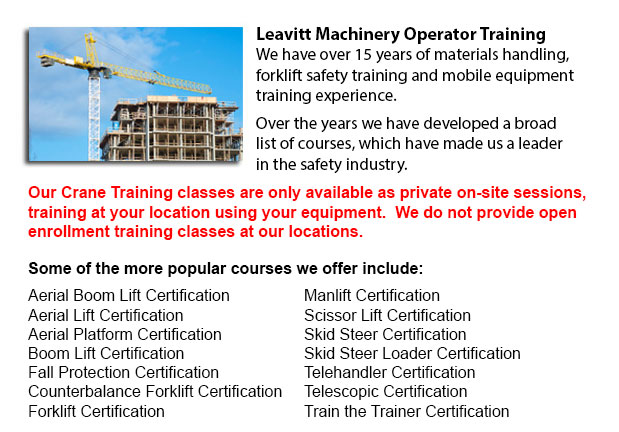
Cambridge Overhead Crane Safety Training - The overhead crane safety training course is designed to equip the operators with the right knowledge and skills in the areas of: crane safety measures, accident avoidance, materials handling, and equipment and stock protection. Each of the trainees will get to learn on numerous types of overhead cranes, their capabilities and their uses in different settings. For operators who are licensed and trained, the shift in liability moves to the operator from the company. Therefore, the program emphasizes individual operator tasks.
The operators in the overhead safety training course will be given instruction about the proper methods for doing inspections: the more detailed in-depth inspection and the pre-shift inspection. These are critical every day routines that must be logged. Properly recorded pre-shift checks help to protect the company from liability in case of an accident. Pre-shift checks likewise prevent costly repairs, accidents and damage. Operators learn how to designate a specific individual to carry out checks, how to maintain the log book and how to report problems.
Inspections should be done on a regular basis and documented properly. The following should inspected while watching for usual problems: increase in the throat opening, hooks for cracks, hoist ropes for corrosion, degree of twist, worn wires, loss of diameter, broken wires, bird caging and kinks, chemical and heat damage; chains for nicks and gouges, twists, cracks and corrosion, distortion, excessive wear, pits, stretching, damage caused by extreme heat.
The operator will get to learn the right ways about proper rigging procedures. The process of rigging involves the understanding of the manufacturer's data plate, determining the material weight to be lifted, choosing the gear, and utilizing safe practices to secure the load. The program cover in detail the following: safe working loads, and the capacities of chains, ropes, hooks, shackles and slings.
It is important to know who could use the cranes at your facility, physical requirements of the job, and operator credentials required for permits and specialized job. Safety is a top priority when utilizing in the vicinity of pedestrian traffic.
Safe crane use involves duties such as undertaking visual inspections, checking for hydraulic leaks, testing the controls, checking the safety guards, examining the hook and hoist rope, limit switches and braking mechanisms. Right reporting procedures are vital. These subject matters are all included in depth in the program.
The program also covers the proper moving and lifting methods with hoists and cranes. Operators will also learn right hand signals. Training includes how to attach the load, raise the load, abort a lift, set the load and unhook the slings.
Moving the load involves a few steps: stopping and starting procedures, controlling and guiding the load, observing working conditions and working with signals. Operators need to know how to proceed in case of a power failure. The course includes techniques for removing the slings and lowering the load, parking the crane, storage equipment, and securing an indoor and outdoor crane.
-
Cambridge Aerial Boom Lift Ticket
Cambridge Aerial Boom Lift Ticket - Aerial lifts can accommodate many tasks involving high and hard reaching places. Often used to perform routine upkeep in structures with elevated ceilings, prune tree branches, raise burdensome shelving units or me... More -
Cambridge Heavy Equipment Training
Cambridge Heavy Equipment Training - The two most common types of heavy equipment training are classed into the categories of machines; equipment that is fashioned with tracks and those with rubber tires. The tracked vehicle are heavy duty equipment... More -
Crane / Overhead Crane / Self-Erect Crane / Truck Mounted Crane / Hydraulic Cranes Training in Cambridge
Overhead cranes are likewise referred to as bridge cranes. They are a type of crane that has a hook and line mechanism which runs along a horizontal beam which runs along two widely separated rails. Several overhead cranes could be found in a long fa... More -
Cambridge Warehouse Forklift Training Classes
Cambridge Warehouse Forklift Training Classes - The reason for warehouse training classes are to raise the awareness of common workplace hazards. Those training would learn necessary warehouse safety procedures. An emphasis is placed on paying attent... More -
Cambridge Heavy Equipment Training School
Cambridge Heavy Equipment Training School - The heavy equipment operator courses would assist the operator in attaining the needed skills and knowledge they would need to be able to enter the workforce as an entry level operator. In this 12 week cour... More -
Cambridge Telehandler Training
Cambridge Telehandler Training - Telehandlers or also called Telescopic handlers are really popular piece of heavy construction machinery most often utilized in construction and agricultural industries. These machines have maximum reaching ability an... More -
Cambridge Boom Lift License
Cambridge Boom Lift License - To operate an aerial boom lift, operators should be certified through training which can be attained utilizing both practical training and classroom sessions and by attaining a boom lift license. Instruction must be give... More -
Cambridge Wheel Loader Training
Cambridge Wheel Loader Training - Normally, the various kinds of heavy equipment training are divided into 2 categories of equipment: those which have rubber tires and tracked vehicles. Tracked vehicles consist of items such as excavators, cranes, an... More

Forklift Certification Cambridge
TOLL FREE: 1-888-254-6157
Cambridge, Ontario
forkliftcertificationcambridge.com
Email Us
About Us


